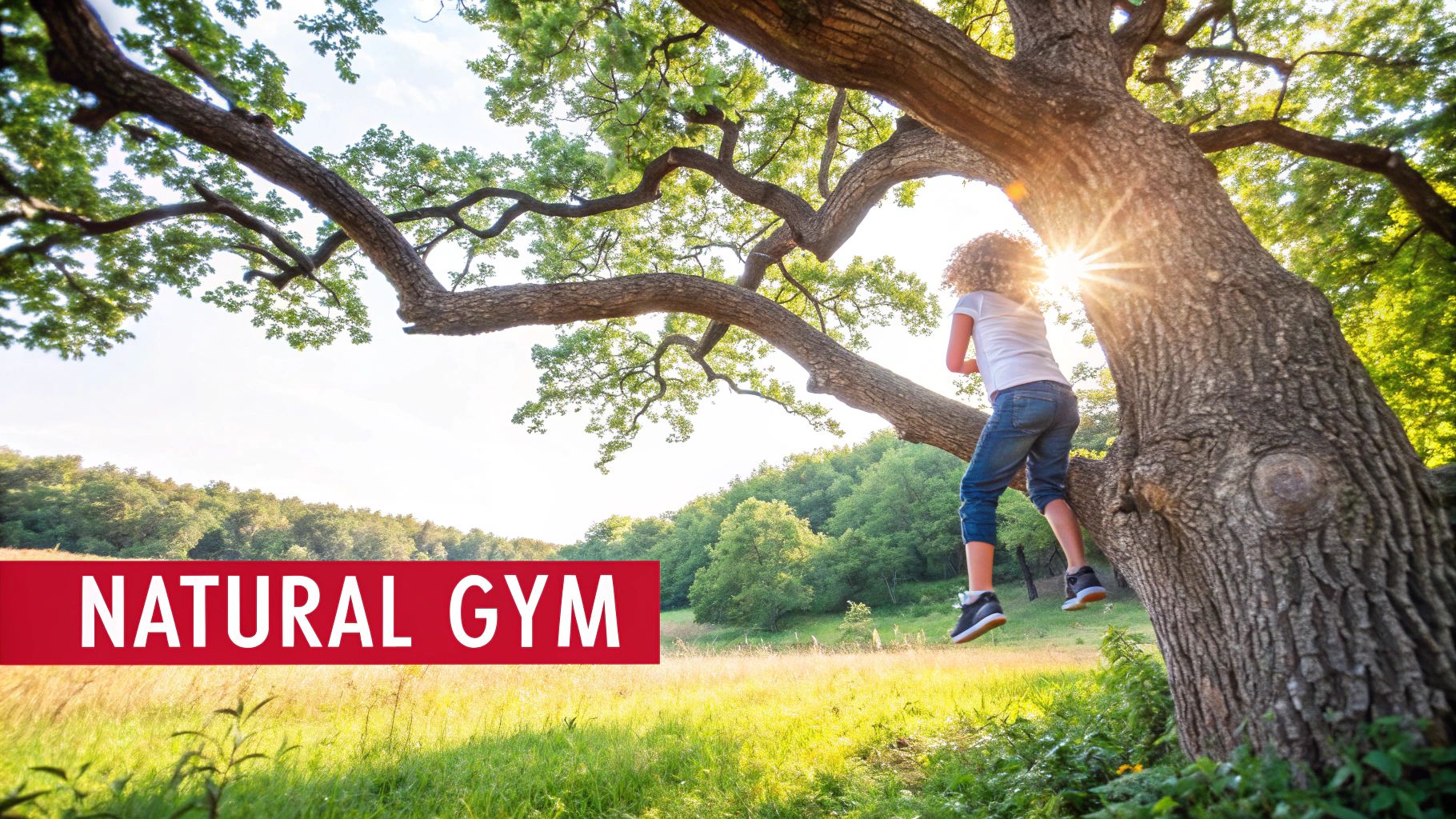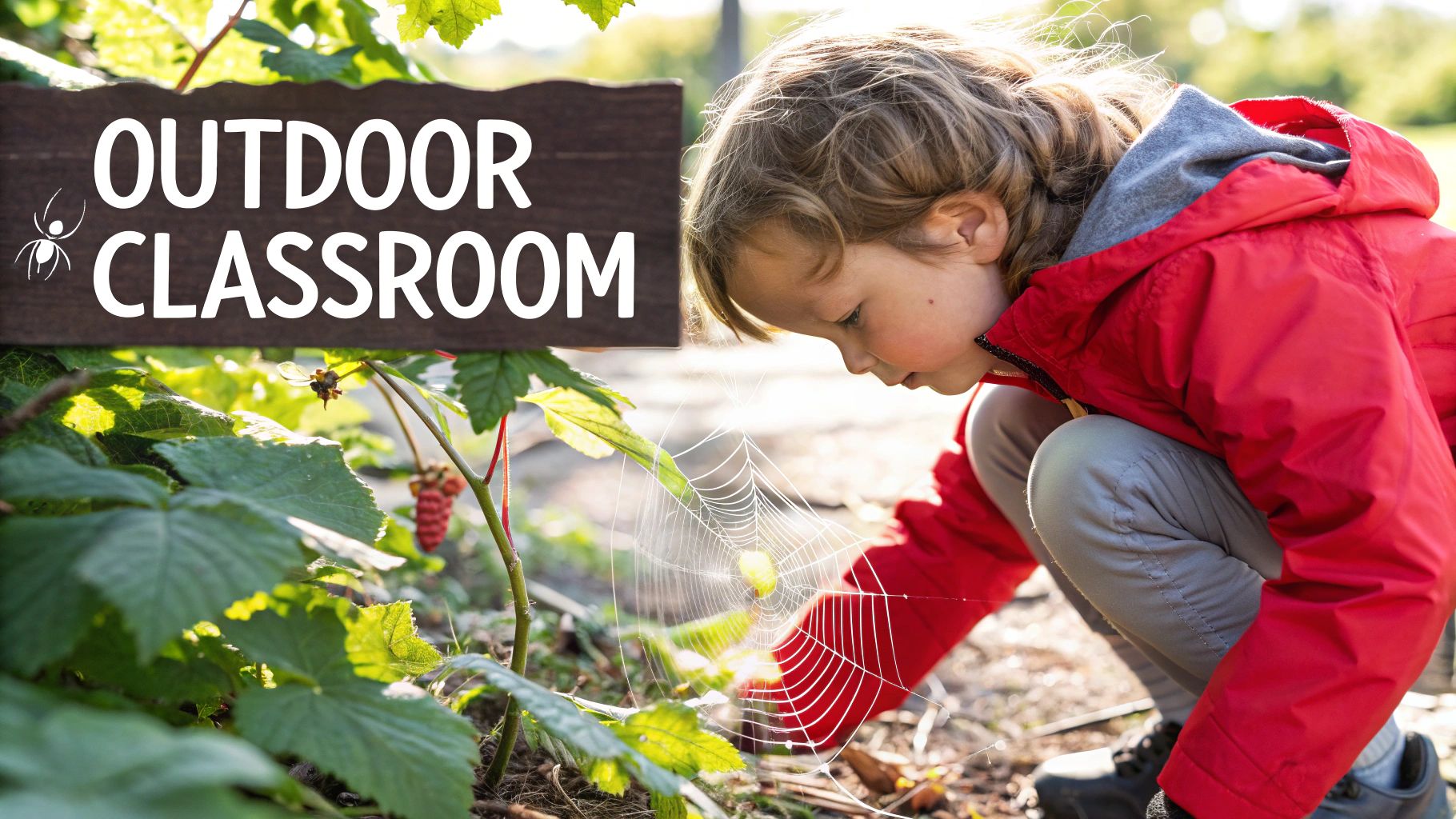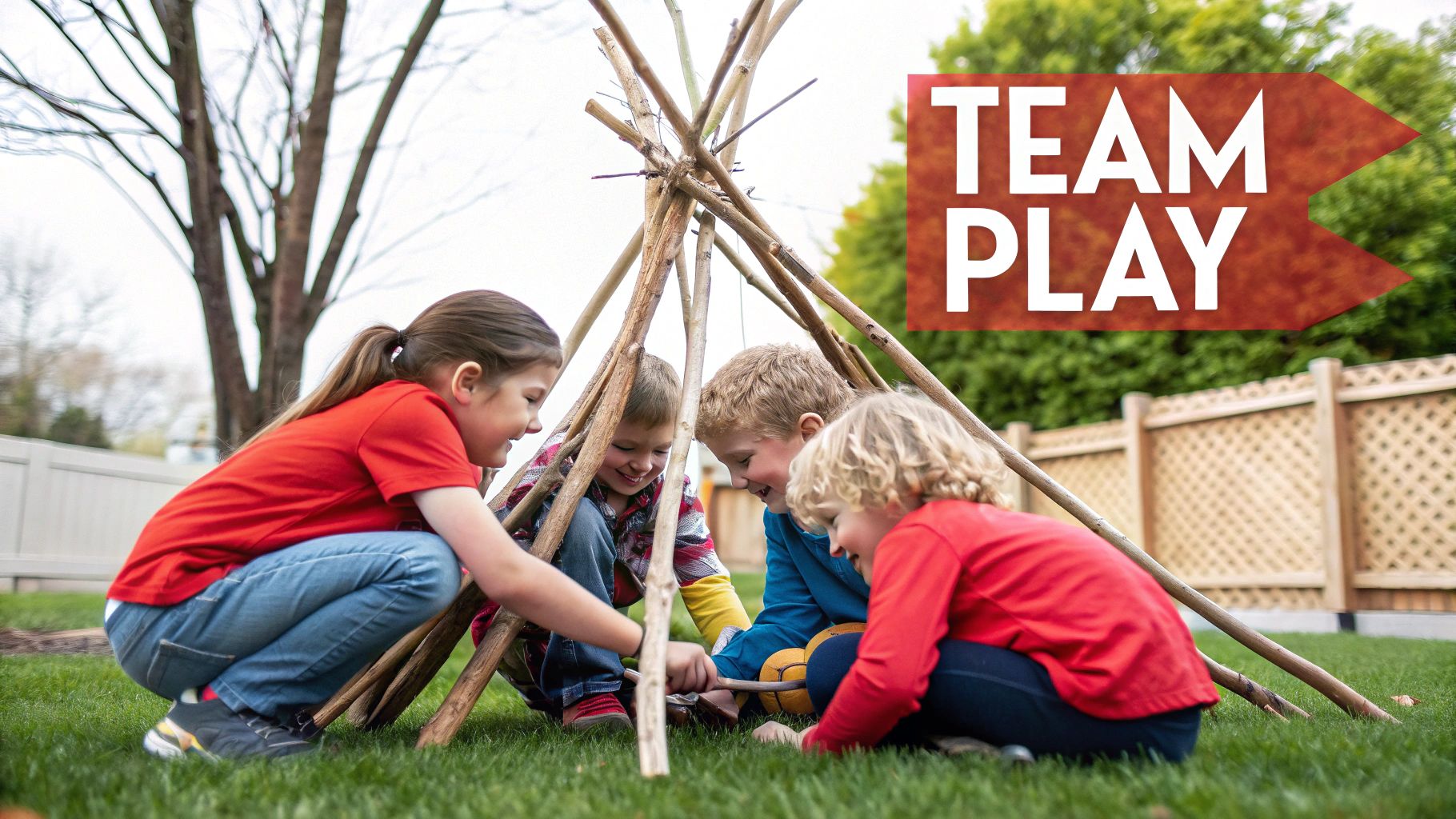
Unlock the Powerful Benefits of Outdoor Play for Child Development
We all instinctively know there's magic in outdoor play. It's far more than just burning off energy; it's a critical engine for a child's physical health, cognitive growth, and emotional well-being. When we give children unstructured time in nature, we give them the space to build stronger bodies, flex their creative muscles, and master social skills in a way no screen ever could.
Why Outdoor Play is a Non-Negotiable for Today's Kids
In a world saturated with digital screens and tightly packed schedules, the simple act of playing outside has become more vital than ever. The unstructured freedom of the great outdoors offers the perfect antidote to the highly managed, predictable indoor environments many children navigate daily. It's their chance to be in charge—to invent games, solve real-world problems, and safely test their own limits.
This isn't just about fun; it's a cornerstone of healthy development. When kids trade a tablet for a patch of grass, they are engaging all their senses, learning to think on their feet, and forging a tangible connection with the world around them. This hands-on experience is something that cannot be replicated indoors.
The Growing Divide Between Children and Nature
The hard truth is that children are spending less time outdoors than any previous generation. A 2021 Canadian study revealed a startling statistic: over 61% of children get less than 70 minutes of outdoor time a day, with some getting none at all. The evidence is clear: every extra hour spent outside directly boosts physical activity and reduces sedentary time, which is a massive win for their long-term health.
This chart highlights the imbalance, showing how screen time is dominating their waking hours compared to active, outdoor fun.
It's clear that screen time often triples the amount of time kids spend playing outside. Reclaiming that balance is a primary challenge for modern parents. For actionable tips, our guide on how to limit screen time offers practical strategies to help your family unplug and reconnect.
To understand the stakes, here’s a quick breakdown of how outdoor play impacts every facet of a child's growth.
Core Benefits of Outdoor Play at a Glance
This table provides a snapshot of the key developmental victories that occur when kids step outside to play.
| Area of Development | Key Benefit | Real-World Example |
|---|---|---|
| Physical | Improved Gross Motor Skills | Scrambling up a play structure or climbing a tree builds strength, balance, and coordination. |
| Cognitive | Enhanced Problem-Solving | Figuring out how to build a stable den from branches or navigating a new path in the woods. |
| Emotional | Increased Resilience | Taking a tumble off a bike, dusting off a scraped knee, and hopping right back on to try again. |
| Social | Better Negotiation Skills | Collaborating on the rules for a game of tag or sharing a single bucket in the sandbox. |
Seeing it laid out like this clarifies that these benefits aren't just a nice-to-have; they are fundamental for raising well-rounded, capable human beings.
Key Takeaway: Think of the outdoors as a natural laboratory for life. It’s where kids learn to negotiate, test physical boundaries, and build the resilience to bounce back from a scrape or a squabble. These are the lessons that truly stick.
Physical Benefits: Building Stronger Bodies and Lifelong Health
Forget sterile gyms—nature is the ultimate playground, perfectly engineered for growing children. While a living room floor is flat and predictable, the great outdoors is a dynamic obstacle course. The beautiful chaos of hills, roots, and uneven ground builds true physical strength and resilience in a way no manicured space can.
This isn't just about letting them run wild. It's about laying a powerful foundation for a healthy life.

Consider what happens when a child runs across a bumpy field. Their body constantly makes micro-adjustments to maintain balance, strengthening core muscles and sharpening coordination far more effectively than walking on a perfectly level surface. Every leap over a puddle or wobbly step on a log is a practical lesson in proprioception—the body's innate sense of its position in space.
Why Uneven Ground is Nature's Agility Course
The outdoors is an organic agility course that builds functional, real-world strength. Instead of reps and sets, children engage in holistic movements. A kid scrambling up a tree uses muscles in their arms, legs, and core simultaneously in a coordinated, powerful effort.
Let's compare:
- Indoors: A child runs back and forth on a flat carpet.
- Outdoors: The same child charges up a small hill, sidesteps tree roots, and hops from one stone to another, engaging a much wider range of muscles and motor skills.
This variety of movement is crucial. It develops everything from gross motor skills like sprinting and jumping to the fine-tuned coordination required to stay balanced. The unpredictable terrain isn't a flaw; it's the main feature.
Key Takeaway: Outdoor play is a full-body workout that kids don't even realize is happening. They’re too busy building forts or chasing butterflies to notice they're also building stronger muscles and denser bones.
Sunlight and Fresh Air: The Foundations of Wellness
The benefits extend beyond muscle development. Playing outside delivers critical health perks that are impossible to get indoors. Sunlight prompts the body to produce Vitamin D, a nutrient essential for calcium absorption and building a strong skeleton. Even a short period of sun exposure each day can make a massive difference in a child's physical development.
Furthermore, breathing fresh air is a simple but powerful health booster. Indoor spaces can trap allergens and pollutants, but time spent outdoors can significantly improve respiratory health. Research supports this, showing that children who play outside regularly often have more robust immune systems. This trifecta—physical activity, Vitamin D, and fresh air—is a powerful recipe for instilling healthy habits that last a lifetime.
Cognitive Benefits: Fueling Curiosity and Brain Growth
While outdoor play builds strong bodies, some of its most profound benefits are cognitive. Nature is the ultimate open-ended classroom, an ever-changing environment that sparks curiosity and nurtures critical thinking skills in ways no pre-packaged toy ever could.

Think of it this way: indoors, a child might play with uniform blocks. Outside, they might try to build a den from fallen branches of varying shapes, weights, and textures. That simple act becomes an impromptu lesson in physics, engineering, and design. This is where the magic of hands-on, unstructured learning strengthens a child's brain. Watching a spider spin a web becomes a biology lesson; a nature scavenger hunt sharpens focus and observation skills.
How Unstructured Play Develops Executive Functions
These outdoor experiences are essential for developing executive functions—the mental toolkit that enables us to plan, focus, remember instructions, and multitask. These are the foundational skills for success in school and in life.
You can see it happening in real-time during play:
- Planning: Deciding how to build a fairy house requires thinking ahead—gathering materials, designing the structure, and assigning roles if playing with friends.
- Problem-Solving: When a makeshift dam in a creek collapses, a child must analyze what went wrong, test new ideas, and adapt their approach. It's the scientific method in action, played out with mud and rocks.
- Focus: A child waiting patiently for a squirrel to emerge from a tree is practicing sustained attention and self-control.
This type of organic learning is at the heart of child development. You can dive deeper into how play shapes the brain in our guide to the benefits of play-based learning.
Key Takeaway: The outdoors doesn't give children answers; it gives them questions. This process of discovery is where true, lasting learning occurs, building a foundation of curiosity that will serve them for a lifetime.
The Proven Link Between Nature and a Sharper Mind
The connection between outdoor play and cognitive development is backed by solid evidence. International surveys show that a staggering 97% of teachers believe outdoor play is critical for children to reach their full potential. Why? Because time in nature is directly linked to better executive function—the ability to plan, focus, and manage emotions, all of which are essential for academic success.
However, a concerning reality remains: less than 20% of children globally get the recommended amount of daily physical activity. This highlights a significant gap between what we know is best for kids and what is actually happening. You can learn more by reading the full report on play. Every minute spent exploring the backyard or a local park is a direct investment in your child’s cognitive future.
Emotional Benefits: Nurturing Resilience and Well-Being
Beyond the physical and cognitive gains, one of the most incredible benefits of outdoor play is its impact on a child’s inner world. Nature serves as a powerful antidote to the pressures of modern life, helping children learn to manage their feelings, reduce anxiety, and build a solid sense of self.
Simply being in a green space has a tangible calming effect. Scientific studies confirm that time in nature lowers cortisol—the body's primary stress hormone—and promotes a feeling of peace. For a child, this isn't an abstract concept. It’s the quiet focus of watching an ant carry a crumb, or the simple joy of lying in the grass watching clouds drift by. These moments of natural mindfulness teach kids how to find a calm center within themselves, an invaluable skill for navigating life's challenges.
Building Confidence Through Small Triumphs
Outdoor spaces are perfectly designed for building resilience. Unstructured play presents an endless series of small, manageable challenges that children can tackle on their own terms. Without adult-made rules or step-by-step instructions, they are free to explore a world of possibilities.
This is where real, earned confidence is forged. Consider these small wins that feel monumental to a child:
- Finally stretching far enough to grab the next branch on a climbing tree.
- Successfully crossing a fallen log without wobbling.
- Building a small stick fort that actually stands on its own.
Each self-directed victory sends a powerful message: "I can do hard things. I am capable." This feeling of competence is the bedrock of self-esteem. It’s not about perfection; it’s about the process of trying, failing, and trying again.
Key Takeaway: The outdoors provides a safe space for children to test their limits and experience healthy risk. A scraped knee isn't just a minor injury; it's a lesson in resilience. It teaches them to dust themselves off, assess what went wrong, and give it another shot.
Fostering Emotional Regulation and Sensory Input
The rich sensory environment of the outdoors is a massive piece of the emotional development puzzle. The feeling of cool mud squishing between fingers, the scent of pine needles after rain, the sound of birds chirping—this sensory input helps regulate a child's nervous system and promotes emotional balance.
For parents looking to enhance this experience, combining nature with intentional sensory play is a game-changer. Our guide to sensory activities for kids is filled with fantastic ideas you can easily adapt for the backyard or a local park. This approach helps your child connect with their feelings through hands-on exploration, turning outdoor time into a powerful tool for raising a resilient and emotionally intelligent child.
Social Benefits: Fostering Teamwork and Lasting Friendships
Watch a group of children playing outside, and you'll see a complex social laboratory in action. They become the architects of their own world. When they team up to build a fort or invent a new game, they are practicing vital life skills without even realizing it. These unstructured moments are where they learn to negotiate roles, share resources, and work through disagreements.
Unlike adult-led activities with predefined rules, the outdoors gives children the space to figure things out for themselves. It’s in those crucial moments—deciding who leads the game or how to move a heavy log together—that real teamwork and conflict resolution skills take root. They learn to listen to different points of view, make compromises, and even step up to lead.

This process is the foundation for building strong friendships based on mutual respect and shared adventures. You can help fuel these collaborative moments with the right tools; our guide to the best toys for imaginative play is packed with ideas to get the fun started.
The Power of Healthy Risk-Taking in Social Development
A significant part of social development comes from what experts call ‘risky play.’ This doesn't mean being reckless; it means allowing children to engage in thrilling, challenging activities where they can test their limits, like climbing a little higher or balancing on a wobbly log.
This type of play is powerful because it teaches children to assess situations, trust their judgment, and understand their physical capabilities. When they successfully navigate a small, self-imposed risk, they build incredible self-confidence.
This feeling of independence is a cornerstone of social-emotional health. Children who are given the freedom to explore and test their boundaries tend to develop stronger social networks and become more effective problem-solvers. Research consistently shows that greater ‘independent mobility’—the freedom to play without constant adult supervision—is directly linked to these positive outcomes.
Building Independence and Social Confidence
Unfortunately, modern life presents many barriers, and not all children get these opportunities. Shocking data reveals that only 8% of Canadian children spend more than two hours a day playing outside. But every minute counts.
Allowing children the autonomy to explore their world helps them build resilience and sharpen their decision-making skills as they navigate unpredictable, natural settings. By providing these opportunities, we empower them to develop the social confidence needed to build friendships that last a lifetime.
Actionable Tips: Simple Ways to Encourage More Outdoor Play
Knowing the benefits of outdoor play is one thing; fitting it into a packed family schedule is another. The good news? You don’t need grand plans or expensive gear. You can spark a lifelong love for the outdoors with a few simple, consistent habits.
First, redefine "outdoor play." It isn't always a five-mile hike. A simple walk around the block can become an "Adventure Walk." Challenge your child to find three different kinds of leaves or spot five red cars, and the mundane instantly becomes magical.
Make It a Daily Habit, Not a Major Event
The key to making outdoor time stick is to weave it into your daily rhythm. Instead of seeing it as another chore, piggyback it onto existing routines.
- Eat Outside: Take lunch or a snack to the backyard. A blanket on the grass transforms a simple meal into a picnic.
- Walk or Bike Short Errands: If possible, swap a short car trip for a walk or bike ride. It turns a chore into a mini-adventure.
- Schedule a 15-Minute "Green Break": Carve out just 15-20 minutes after school or dinner for family time outside. Kick a ball, draw with sidewalk chalk, or chase bubbles.
These are small, consistent actions that build a powerful routine over time.
"To be healthy, children need several hours (not minutes!) of movement a day — preferably outdoors, where the senses are fully alive and their bodies are free to move in many different ways."
Spark Curiosity with Simple "Invitations to Play"
Sometimes, a small nudge is all it takes to unlock a child's imagination. A few simple, open-ended tools can turn a familiar backyard into a universe of discovery.
Create a "Nature Treasure Box" for cool rocks, feathers, and acorns. This gives their explorations a sense of purpose. You can also create an "invitation to play" by leaving a bucket and shovel in the sandbox or a magnifying glass on the porch steps. These prompts encourage child-led fun, which is the heart of hands-on learning. For more ways to foster this creativity, explore these play-based learning activities. It's about empowering them to take the lead, one adventure at a time.
Frequently Asked Questions About Outdoor Play
Even with the best intentions, practical questions and worries can arise. Let's tackle some of the most common concerns to make getting outside a smooth, joyful part of your family's routine.
How much outdoor play is enough?
Most experts recommend at least 60 minutes of physical activity daily, with a significant portion happening outdoors. However, consistency is more important than hitting a specific number. Even 20-30 minutes of focused outdoor time each day makes a huge difference. The goal is to weave it into your daily life so it feels natural, not forced.
What if we live in a city with no backyard?
You don't need a sprawling yard to reap the benefits of nature. Cities are full of opportunities for exploration.
- Local Parks and Playgrounds: Explore different parks in your area to keep the adventure fresh.
- Community Gardens: These green spaces are a goldmine for sensory experiences—different textures, smells, and colors.
- Urban Adventure Walks: Challenge kids to find interesting weeds growing through pavement, spot unique insects, or notice architectural details on buildings. Sidewalk chalk and bubbles are just as magical on concrete as on grass.
How can I handle safety without hovering?
This is the classic parenting dilemma: ensuring safety while fostering independence. The key is to empower your children with knowledge. Start by setting clear, simple ground rules (e.g., stay where you can see me). Then, try supervising from a distance. This gives them space to problem-solve and build confidence. Allowing for healthy ‘risky play’—like climbing a small rock wall—is crucial. It teaches kids to assess situations, understand their limits, and trust their judgment.
What should I do when my child says, "I'm bored" outside?
When you hear "I'm bored," see it as an invitation. Before jumping in with suggestions, offer a simple "invitation to play." This might be handing them a bucket and shovel, a magnifying glass, or old pots and pans for a mud kitchen. These open-ended items don't come with a rulebook, allowing your child to become the director of their own adventure and sparking imagination in a way structured toys often can't.
At Playz, our mission is to fuel that natural sense of adventure and discovery. Our science kits and creative toys are designed to transform any outdoor space—big or small—into a laboratory for fun, learning, and growth. We are here to help you unlock all the incredible benefits of outdoor play.
Ready to inspire your child’s next great adventure? Explore our collection at https://www.playzusa.com.
